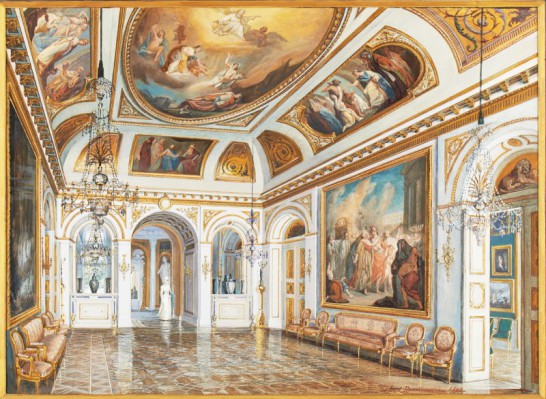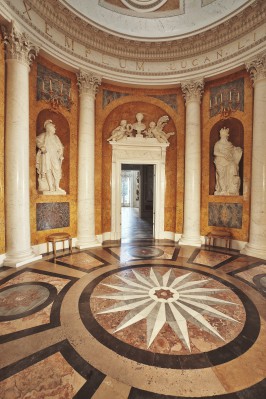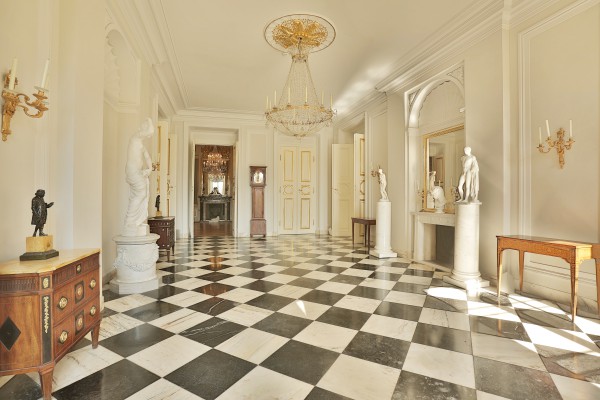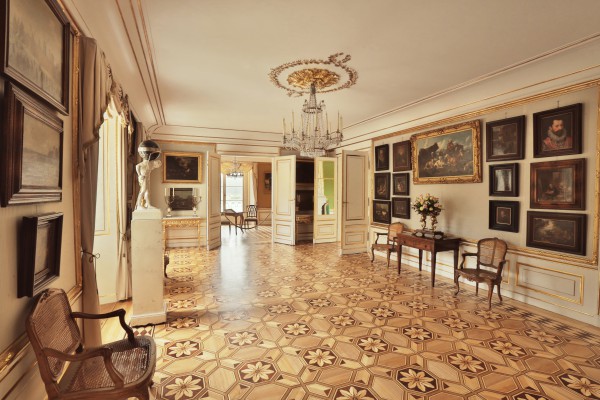
The Salle de Salomon
Also known as the Company Room or the Summer Room. In the villa bought from Lubomirski, this room was octagonal in plan. It was lined with mirrors and a light-coloured stucco shaped in oval and polygonal medallions, vases, and garlands. Painted decorations alluded to water motifs. Following the expansion of the Palace in 1788, the room gained a rectangular shape, most likely according to a design by Domenico Merlini. In the summer residence of Stanisław August, it was used as a lounge, where the King received his guests. This was the place for conversing and playing Whist on two tables. In 1793, the room was given a new decor, which contributed to its present name. Monumental paintings by Marcello Bacciarelli depicting the life of the Biblical King Solomon became the most important elements of the room’s decoration. These paintings were destroyed during the last war. However, owing to the accounts which preserved, we know that the face of Solomon was modelled on Stanisław August himself. In addition, some persons from the King’s entourage – mainly beautiful ladies (including the King’s closest friend, Elżbieta Grabkowska) – were depicted as the other characters present in the scenes. The comparison of the Polish King to Solomon – known for his wisdom – conveyed a symbolic meaning. In the time of the Enlightenment – the Age of Reason – each of Europe’s monarchs wanted to liken themselves to Solomon. Among the claimants to this name was Stanisław August, whom Voltaire called the “Philosopher King”. The plafond of this room was decorated with the depiction of Solomon’s Dream. The bevel, i.e. a slightly rounded, wide strip between the walls and the ceiling, contained the following scenes: Deliberation with King Hiram, Judgement of Solomon, and the Visit of the Queen of Sheba. The opposite walls were covered with two large canvases: Dedication of the Jerusalem Temple, and the Solomon’s Sacrifice. The series was supplemented with painted depictions of arabesques and the allegory of the Four Elements presented as animals (dolphin, peacock, salamander, and lion) by Jan Bogumił Plersch, and gilded mouldings, which contrast with the whiteness of the wall. The arrangement of the Salle de Salomon, which combines paintings, ornamental decorations, mouldings, and rich equipment, is exemplary of Stanisław August’s interiors. The beautiful parquet – made of eight types of wood – was designed by Johann Christian Kamsetzer.
Currently, the Salle de Salomon functions as a gallery of paintings. The room houses, among others, four round paintings by Marcello Bacciarelli – the so-called tondos, which depict the virtues of: Prudence, Justice, Clemency, and Courage. These paintings originally hung in the Rotunda’s cupola, the current location of the Four Times of the Day. It is worth paying attention to the personification of Courage, which is modelled on Stanisław August. The virtue of Clemency is most likely the portrait of Elżbieta Grabowska.




















